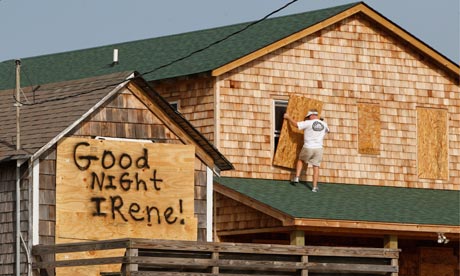 She came…She went…
In my neck of the woods, she ushered in a wet basement and a few hours without power. Can we say Good Night, Irene? My family may have been spared, but many in neighboring towns were not so lucky. Along with suffering from the aftermath of the hurricane, they are enduring the type of political storm that arrives when the Tea Party comes to town.
She came…She went…
In my neck of the woods, she ushered in a wet basement and a few hours without power. Can we say Good Night, Irene? My family may have been spared, but many in neighboring towns were not so lucky. Along with suffering from the aftermath of the hurricane, they are enduring the type of political storm that arrives when the Tea Party comes to town.
Politics and disasters are strange bedfellows…they separate the humane from the monsters. Please bear with me as I wade into the local political realm and tell you about two Republicans who left an impression in the wake of Irene.
The first one was Mayor Bloomberg of New York City. Given the reports and the facts - the odds of Irene wiping out parts of the city were high. Bloomberg made the right call. He evacuated low-lying areas and shut down the transit system. While the storm didn't hit as directly or devastatingly as expected, that doesn't change the levelheaded choices the Mayor made for his people. Bravo Bloomberg.
On the other end of the GOP spectrum, and a few miles north of NYC, days after Irene ripped through neighboring areas of Orange, Dutchess, Putnam and Westchester Counties, Rep. Nan Hayworth is threatening to withhold disaster money if lawmakers don't cut additional spending from the federal budget. Yes, this is the same Nan Hayworth who outspent and won the election out from under the fabulous Rep. John Hall…and yes, Hayworth was a Tea Party candidate.
Hayworth is saying she would only vote to replenish the federal disaster fund if new spending is offset by budget cuts. According to her, those cuts should come from "non-defense discretionary spending." Hayworth likened her position on bringing more pain and suffering to those affected by Irene, to “a family skipping vacation if it was overwhelmed by bills.”
"We're facing a natural disaster in the middle of an economic disaster. Certainly, the challenges we face with the national budget have not changed."
No they haven’t, but people's lives have changed.
It makes me sick to think an elected official would hold its constituents hostage. It's almost a week after the storm, and as I drive around the area, the devastation is horrifying...so many are left with flooded homes, crumbling roads, no water and no power. What are they supposed to do? These folks have been paying taxes just for an emergency such as this. Will they lose their homes while Hayworth positions the politics in her favor? Disgusting.
If you can stomach more of this type of nonsense, read today's NYTimes op-ed from Paul Krugman, Eric and Irene.
 OK, I’ll stop now because you may have just checked in to see my latest, greatest eco-finds. Those are coming, I promise. But, Irene has been on my mind, and it inspired a few non-political posts from me that you may want to check out. This one over on Moms Clean Air Force site, and this one at Care2 discuss the after effects of hurricanes on wildlife, pollution and our stuff. Of course, in both posts I couldn’t repress my deep feeling that climate change is at the root of many of these latest natural disasters. That’s not politics. That’s reality.
OK, I’ll stop now because you may have just checked in to see my latest, greatest eco-finds. Those are coming, I promise. But, Irene has been on my mind, and it inspired a few non-political posts from me that you may want to check out. This one over on Moms Clean Air Force site, and this one at Care2 discuss the after effects of hurricanes on wildlife, pollution and our stuff. Of course, in both posts I couldn’t repress my deep feeling that climate change is at the root of many of these latest natural disasters. That’s not politics. That’s reality.
Credits: Charles Krupa/AP for New York Times, Charles Dharapak/AP for Guardian






